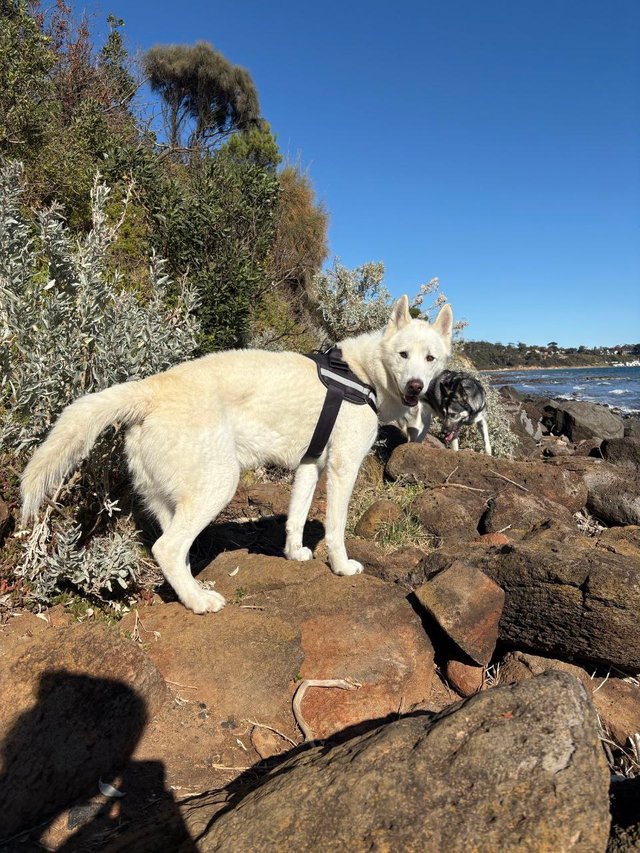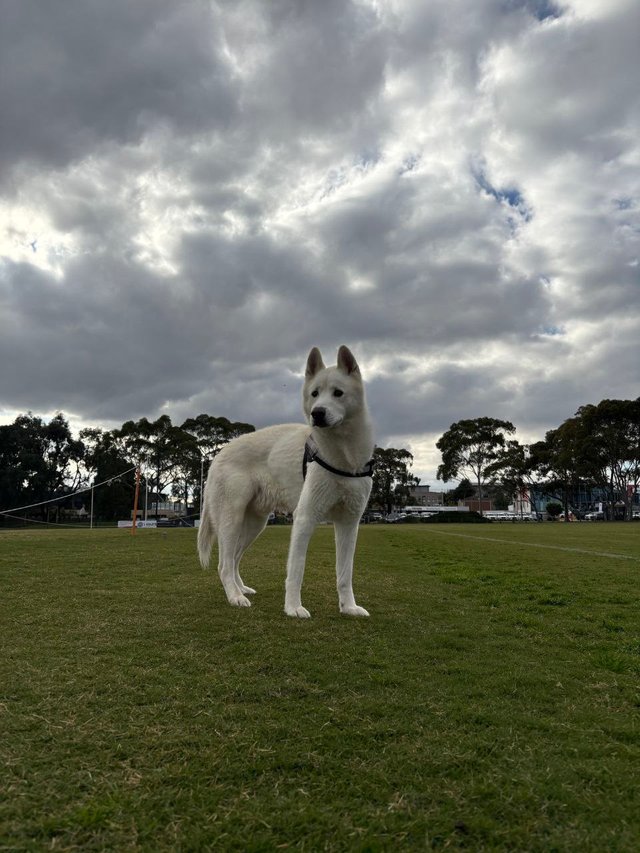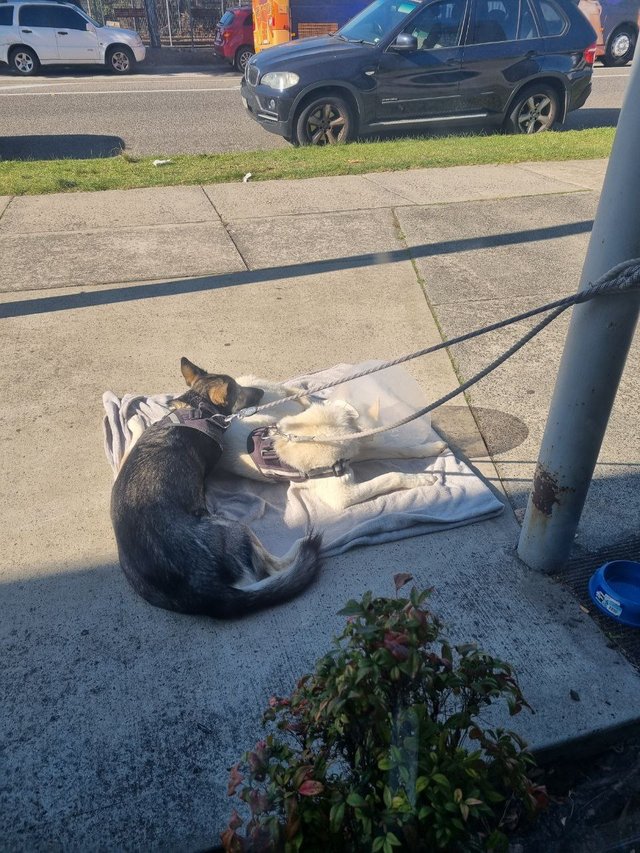Polar Inu Update: 1 Week with DMSO & 2 Months on Dr. Makis’s Protocol – A Journey of Hope!
Tomorrow, May 26, marks exactly 1 week since we introduced DMSO (0.3ml, 50% solution) to Polar’s regimen on May 19—a new step to enhance the impact of his topical ivermectin for ASAC. For those following Polar’s journey, our 10-year-old white Siberian Husky was diagnosed with anal sac adenocarcinoma in July 2024, facing a grim 5–10% survival chance without standard care. Yet, with the $POLAR community’s support and Dr. William Makis’s protocol, Polar has defied the odds!
DMSO Implementation: First Week Recap:
We started DMSO at 1x daily for the first 2 weeks, as advised, and tomorrow concludes Week 1. We’ll continue 1x daily until June 2 (the 2-week mark), when we may increase to 2x daily (AM/PM) if needed. DMSO is applied topically, followed 1–2 minutes later by ivermectin (now using Equimax horse paste, 1.87% ivermectin, evolved from Soolantra under @MakisMD’s guidance). This timing allows DMSO to act as a carrier, making ivermectin up to 5x more absorbent by rapidly penetrating the skin and spreading throughout the body. This increased absorption prompted us to slightly reduce Polar’s oral ivermectin dose to avoid potential over-dosing, ensuring we stay within safe limits while maximizing efficacy.
But is the 2x daily DMSO necessary? From what we’ve learned, if no noticeable improvement is seen by around June 2 (~2 weeks), increasing to 2x daily can help boost the protocol’s effectiveness. Since we’re only at the end of Week 1, we’ll monitor Polar closely over the next week before deciding. If we do increase to 2x daily, we may need to further adjust his oral dose slightly—likely a 10–15% reduction—to account for even greater absorption, keeping the focus on Dr. Makis’s tailored protocol as the primary driver of Polar’s care.
2 Months on Dr. Makis’s Protocol: Where We Stand May 30th marks 2 months since Polar’s full protocol implementation (March 30, 2025), following his MDR1 gene test clearance on March 29. An interim protocol ran from March 9 pending the test, ensuring safety with ivermectin.
Here’s Polar’s progress:
Inflammation: Slashed within days of starting ivermectin, and it’s stayed down through today—a major win!
Secondary Tumor Sites:
Most have vanished, with the gland contour ~100% restored. However, one stubborn late bloomer site persists, needing as much attention as the primary site. Unlike the primary, this late bloomer site has never come to the surface, split, or bled, and doesn’t appear likely to do so—it sits deeper under the skin, making it a different challenge but equally critical to address.
Primary Tumor Site:
I call this the “primary” because it was the original tumor site. It’s no longer as inflamed and pronounced as it once was; it has sunken in, now level with the gland itself, a sign of progress from its earlier state. However, it has a history of coming to the surface, splitting, and bleeding extensively. Thankfully, topical ivermectin (horse paste) has stopped the bleeding, building on the earlier Soolantra success, and the site is now very surface-level and flattening slightly. Both the surface-level primary site and the deeper late bloomer site could benefit significantly from DMSO’s penetration—its ability to target both the surface and deeper layers works in our favor as we aim to hit these two remaining primary sites.
Polar’s early response was incredible—tumors initially spread aggressively, enveloping healthy gland tissue like a literal ticking clock, with the remaining healthy tissue representing the only time we had to achieve a tide-turning event. Dr. Makis’s protocol halted this relentless progression, a critical turning point that preserved Polar’s quality of life. Now, at nearly 2 months, things seem stable: no spiraling growth, but also no dramatic shrinkage of the primary or late bloomer sites. This perceived stagnation makes us nervous—are we on track for remission, or just managing the disease?
Dr. Makis’s Guidance & Timelines:
Our coaching with @MakisMD (started March 9 or March 30, depending on interpretation) is set to expire soon, but we aim to extend it if funds allow—$POLAR’s community support (260x surge to $1.3M ATH) has been vital despite scam setbacks. June 30 marks the end of Polar’s 3-month protocol phase. In a canine lymphoma case under Dr. Makis’s care, remission was achieved in ~3 months, with testimonials often showing noticeable tumor shrinkage within 1–3 months, depending on cancer type and aggression. Polar’s 20–30% remission chance (as of Week 11) aligns with these timelines, but ASAC’s unique challenges mean we must remain vigilant.
Concerns & Next Steps:
The rapid drop in inflammation and blood volume (noted in prior Steemit posts) suggests oral ivermectin is key to maintaining this bleed-free streak. However, the slow progress of the primary and late bloomer sites has us questioning if we’re doing enough. We’ve added vitamin E and bicarb soda (1.4g/day) in the past few weeks, replacing an earlier batch discarded due to quality concerns. These additions support the protocol, but what’s beyond DMSO? Some have explored injecting ivermectin directly into tumor sites, but Dr. Makis’s testimonials show tumors shrinking without such measures—his protocols (ivermectin, fenbendazole, mebendazole) target cancer cell microtubules systemically, often yielding results without invasive methods.
Our Perspective & Predictions:
Polar’s stability is a significant achievement—tumors aren’t progressing aggressively, and healthy tissue is preserved, a stark contrast to the early days when ASAC threatened to overtake everything. However, the primary and late bloomer sites’ slower progress has us wondering when we’ll know if full remission is achievable. While June 30 marks the 3-month point of Polar’s protocol, remission isn’t a strict deadline. In Dr. Makis’s canine lymphoma case, remission was achieved around 3 months, but ASAC’s complexity means timelines can vary. Some of @MakisMD’s testimonials show tumor shrinkage continuing between 3 to 6 months, with full remission sometimes occurring at 3.5, 4, or even 5.5 months, depending on the cancer’s response and adjustments to the protocol.
Given Polar’s rapid early response—inflammation slashed within days, most secondary tumors gone by Week 11, and the primary site showing slight flattening—we’re optimistic. If the primary and late bloomer sites continue to shrink noticeably over the next 1–3 months (by July or August 2025), remission remains a strong possibility. If, by 5–6 months (August–September 2025), these sites haven’t significantly reduced, it may indicate the cancer is being managed rather than fully eradicated, though this would still extend Polar’s quality of life far beyond initial expectations. The DMSO increase on June 2, if needed, and ongoing tweaks like vitamin E and bicarb soda, could accelerate progress. We trust Dr. Makis’s protocol as the cornerstone, and extending his guidance beyond June will help us navigate this critical phase.
Join Polar’s Fight!
Polar’s journey inspires us to revolutionize canine cancer care through crypto. Share his story, support $POLAR (contract: 489VqxA4P6Geg3hUDJEfUxD79mU5axaDnX8Fzauepump), and let’s keep fighting for remission!
PolarInu.xyz | #PolarInu #SavePolar #CanineCancer



